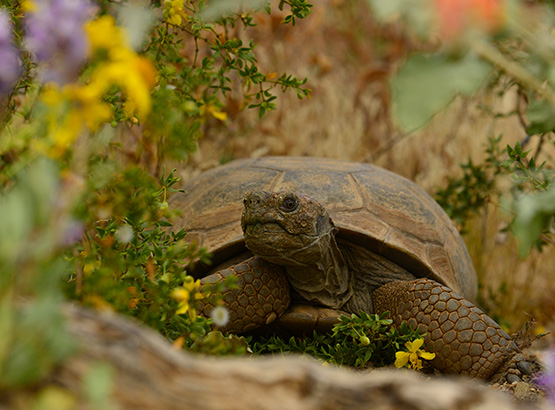Desert Tortoise
Arizona has two native species of tortoise, the Sonoran desert tortoise, Gopherus morafkai; and the Mojave desert tortoise, Gopherus agassizii.

About
The desert tortoise is an herbivorous and completely terrestrial turtle with a brown, high-domed shell and stout, elephantine legs. One of six members of the testudinidae family in North America, the desert tortoise inhabits the desert ecosystems of the southwestern United States and northern Mexico.
The desert tortoise has many remarkable behaviors and traits that make it well-suited for life in the desert. Because it is ectothermic, it controls its body temperature by using a shelter. The shelter protects the tortoise from the extreme heat or cold of the desert. It provides a constant climate that keeps the tortoise cool when the weather is hot, and shelters it from freezing temperatures during hibernation in the winter.
Mojave and Sonoran desert tortoises are protected throughout Arizona. Since 1988, it has been against Arizona State law to harass, harm, pursue, hunt, shoot, wound, kill, trap, capture, or collect this animal in any part of the state.
Conservation
Primary threats to survival of the desert tortoise are related to loss and degradation of the species’ habitat, through drought, wildfire, habitat destruction and fragmentation, and invasion of exotic plant and wildlife species. Other impacts to the species include removal of individuals from the wild, vandalism, mortality from vehicles, irresponsible off-highway vehicle (OHV) use, release of captive tortoises into the wild and disease.
The desert tortoise and other North American tortoise species can become infected with a disease called Upper Respiratory Tract Disease. Once a tortoise is infected with this pathogen it will be a carrier for life. The symptoms may go away, but can re-emerge if the tortoise is under stress.

Our Mission
To conserve Arizona’s diverse wildlife resources and manage for safe, compatible outdoor recreation opportunities for current and future generations.
Ready To Get Involved?
Adopt a tortoise
Each year the Arizona Game and Fish Department adopts out hundreds of captive desert tortoises that are surrendered to the department. These tortoises cannot be released back into the wild because captive tortoises can transmit diseases that can decimate our wild population.
TAP@azgfd.gov
